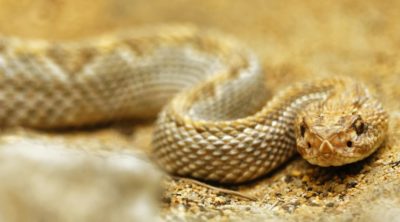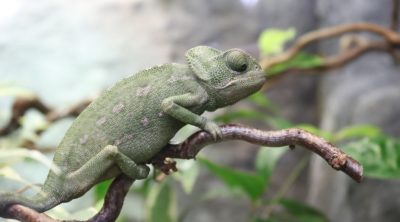
Leopard Geckos are lizards found dwelling on ground, mostly in the deserts of countries like Iran, Afghanistan, Pakistan, and some parts of India. They are one of the most popular pets in North America as they are low maintenance and hardy. If you are a proud owner of this beautiful, colored lizard, then, this PetPonder article will brief you about the dos and don’ts of feeding your pet.
Did You Know?
When Leopard Geckos shed their skin, they consume it rather than hide it. This is a trick which most of them pick up when they are in the wilderness. It is a defense mechanism they use to make potential predators unaware of their presence.
Leopard Geckos has been captive-bred in the United States since the 1980s. Most people sell captive-bred reptiles rather than the ones caught in the wild. Unlike other reptiles, Leopard Gecko have movable eyelids, and tend to clean their eyes with their tongue.
They vary in size and shape with adult geckos about 8 to 11 inches in length, and their weight is somewhere around 45 to 65 grams. Geckos in wild possess dull and dark colors on their skin; whereas, the ones in captivity have an assortment of various colors and beautiful patterns. They make great pets for kids above 10 years due to their small size and friendly, docile nature.
However, you need to be cautious when kids handle their pet. leopard geckos only bite when in defensive postures otherwise they are calm, and never try to bite. They are nocturnal, so don’t expect them to entertain you during daytime. They will be active and fresh just like an owl during nighttime. They are insectivores, and very less picky about their food.
Let’s take a look at what they eat, and what you should feed them.
What do Leopard Geckos eat?
Leopard geckos are insectivores, meaning they only eat insects, and that too, live ones. So, if you try feeding your pet a dead roach or a dead and silent cricket, they won’t eat it. Their diet is really important, and you need to be careful about their eating habits to maintain their health. Before buying a Leopard gecko, make sure to find a regular supplier of their food.
What To Feed
Leopard geckos will eat anything that wiggles in front of them, but obviously some insects are not safe for them to eat. They are known to change their eating habits as they grow up, so don’t be surprised if one week they eat crickets, and the next, they don’t. You may have heard the quote, “Variety is the Spice of Life.”, follow this rule while feeding your beloved pet. Many owners feed them with different variety of insects. Don’t feed insects that are large in size as they will have trouble digesting it. The general rule is to purchase insects which are smaller than the size of your gecko’s head.
Silkworms
They are pretty expensive, and definitely difficult to get a hold of. They are loaded with essential vitamins and minerals which is necessary for your pet. However, they generally have a very short shelf life, maybe a week. So, if you are planning to feed it silkworms, make sure you do but in small quantities.
Crickets
They are the easiest to lay your hands on and the most common insect fed to leopard geckos. Crickets are very active insects, which you may have already figured due to their constant chirping; that’s why, they act like a stimulant to the geckos. They are not expensive and are easy to digest. Crickets contain essential vitamins, protein, and calcium. If you are feeding crickets to your gecko, you need to make sure to put just two or three in front of them because when you serve them way too many crickets, they may feed on your pet. Not directly consume the complete lizard, but feed on several soft spots like their eyes or tail. Also, make sure to feed the crickets because hungry crickets inside the enclosure will feed on the feces of the gecko, ingesting parasite eggs, and when your gecko consumes these insects, those eggs will hatch inside its stomach. Try not to buy large crickets because it will be difficult for geckos to eat them. Put five to eight crickets at a time, once per day inside the enclosure for a baby gecko, and for adult geckos, probably five to ten, every two to three days, would be sufficient.
Dubia Roaches
Geckos find them delicious, also, they are known to be healthy and rich in proteins. It is very easy to breed this species of roaches. Many owners, instead of buying, will breed them at home to save money.
Wax Worms
These worms are treats for a gecko, therefore, you should stick to feeding them wax worms, once or twice a week. These worms have high fat content, hence, are beneficial for lizards who are skinny and need that extra bit of fat. They are considered as junk food, and that’s why, less the better.
Meal Worms
Another staple diet for geckos, you can buy meal worms in bulk and store them in the refrigerator for days. Since they are creepy and crawly, there is no chance of them jumping around and escaping the enclosure. It is necessary to gut load your meal worm before presenting them as food to your gecko. This is so because worms will eat this gut load, and in turn, geckos will eat these worms plus the gut load in their tummy, a double feed for them. So, it’s a win-win situation for your pet. You can keep a small piece of moist carrot in the feeding dish for the worms to crawl around and feed on the carrot, and this, will stimulate geckos to eat them. You can feed your geckos twenty to thirty meal worms at a time.
Locusts
To bring variety in your gecko’s diet, you can, sometimes, chip in locusts instead of crickets. They are very popular with this species of lizard. Cost wise, they are a bit expensive, and packed with varied nutrients. You can feed them, at least five to eight at a time, once daily.
Pinky Mice
They love the one- day-old pinky mice, but strictly keep it as a treat because, again, this animal has high content fat. Some give it to female geckos, who have recently laid eggs, to help them gain back their weight, and of course, for added nutrition.
Water
It is a very important factor in anyone’s diet, a small dish of freshwater should be present at all times inside the cage. The bowl should not be so large that your gecko can take a bath, and not too small either. You can use plain tap water as well and serve it in any type of dish which is not too tall.
Insects to Avoid
All sorts of insects which glow such as Fireflies, Lightning bugs should not be fed to your leopard gecko. Chemicals which help these insects glow or light up in the dark are harmful and toxic, so such insects should be avoided at all costs.
If you have caught any sort of insects at home such as moths, butterflies, cockroaches, abstain from feeding it to your pet. The reason being many insects contain parasites that can cause a stomach infection in your gecko, also, the pesticides consumed by these insects are toxic for your pet.
Other Nutrients
Humans depend on several other factors for their nutrient intake like having a protein shake, fruits, vitamins, and minerals tablets such as iron tablets, calcium supplements, etc. Likewise, even lizards require additional dietary fibers which can be provided by gut loading diets or dusts that increase the nutrient level. Calcium is extremely important because lack of it in a lizard will have health conditions such as weak legs, bent backs, and several other abnormalities. It is highly recommended for baby geckos.
Dusting
Dusting is a process where you dust the insects with dusting powder like vitamin and calcium supplements just before you feed your pet. One way you can dust these bugs is to put both the insects and tiny amount of powder in a glass jar, and shake it until they are lightly dusted. But, make sure to feed your gecko immediately after dusting the insects. This way, they will get their additional nutrition too.
Gut Loading
Gut loading is loading nutritious and healthy food into the bugs before you feed them to your gecko as food. There are several commercial cricket or other insect feed available in the market. Always gut load these bugs 12 hours before feeding them to your gecko, to help them retain all the nutrition in their body.
In case, you are feeding them meal worms, gut load them with a small carrot piece 24 hours before feeding them. You can even leave small carrot pieces in a dish with meal worms for your gecko to feed on.
Feeding Schedule
It depends mostly on their health; young and growing geckos should be fed everyday with four to eight insects. Adult geckos who are 1 or 2 years old can be fed on alternate days with five to ten insects. If your gecko is weak or unwell, they should be fed everyday till the time they become healthy.
Most lizards will stop eating when they are full, but some will still gulp down food. Make sure, you don’t overfeed your pet as this will cause obesity. Like humans, geckos too store fat in their stomach and tail. If you feel your gecko is gaining unnecessary weight, cut back on the quantity of feed and reduce insect feeds which have fat.
Feed your gecko late in the day or early in the evening. They are known to be lazy during daytime and active at night, so they will be more hungry at night.
Sometimes, you may notice that your gecko won’t eat, it’s best to consult a vet at such a time as this. Once you set their feeding routine, your pet Leopard Gecko. won’t face any health problems ever.

